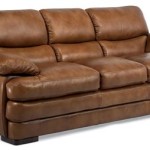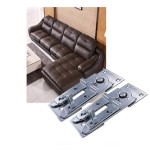How To Recycle An Old Sofa
The disposal of large furniture items, such as sofas, presents a significant environmental challenge. Landfills are increasingly burdened with bulky waste, and the production of new furniture consumes valuable resources. Recycling an old sofa, therefore, becomes a responsible and environmentally conscious alternative. This article provides a comprehensive guide on how to effectively and responsibly recycle an old sofa, minimizing its environmental impact and potentially contributing to a more sustainable future.
Before initiating any recycling process, it's crucial to assess the sofa’s condition and determine the most appropriate method of disposal. A sofa in relatively good condition may be suitable for donation or resale, while a heavily damaged sofa will require dismantling and material separation for component recycling. The following sections outline various methods for recycling old sofas, each tailored to different scenarios and levels of commitment.
Determining Sofa Condition and Exploring Donation Options
The first step in responsibly disposing of an old sofa involves a thorough assessment of its condition. Examine the upholstery for tears, stains, and significant wear. Evaluate the structural integrity of the frame, checking for broken supports, loose joints, and sagging springs or cushioning. Consider the overall cleanliness of the sofa; heavily soiled or infested sofas may not be suitable for donation and are best directed towards recycling or disposal.
If the sofa is in reasonably good condition, donation becomes a viable option. Numerous charitable organizations and non-profit groups readily accept furniture donations, providing it meets certain criteria. Organizations such as Habitat for Humanity ReStore, Salvation Army, and local furniture banks often accept gently used sofas. These organizations typically have specific requirements regarding the type and condition of furniture they accept. It's essential to contact the organization beforehand to verify their acceptance policies and arrange for drop-off or pick-up services. Some organizations may offer free pick-up services, while others may require the donor to transport the sofa to their designated location.
Prior to donating, thoroughly clean the sofa. Vacuum all surfaces to remove dust and debris. Address any minor stains with appropriate cleaning solutions. Repair any loose buttons or minor tears in the upholstery. Presenting the sofa in the best possible condition increases its chances of acceptance and maximizes its usability for its new owner. Documenting the donation with photographs can be useful for tax deduction purposes, as donations to registered charities are often tax-deductible. Keep donation receipts for your records.
Beyond charitable organizations, online marketplaces and local classifieds offer platforms for selling used furniture. Sites like Craigslist, Facebook Marketplace, and Nextdoor allow individuals to list their sofas for sale, reaching a wide audience of potential buyers. Clearly describe the condition of the sofa, including any flaws or imperfections. Provide detailed photographs that accurately represent the sofa's appearance. Set a realistic price based on the sofa's condition, age, and comparable listings. Be prepared to negotiate with potential buyers and arrange for pick-up or delivery options. Ensure all transactions are conducted safely and securely.
If donation or resale are not feasible options due to the sofa's condition, dismantling and component recycling offer a more environmentally responsible alternative to landfill disposal. This process involves separating the sofa into its constituent materials, such as wood, metal, fabric, and foam, and recycling each component individually.
Dismantling the Sofa for Component Recycling
Before beginning the dismantling process, gather the necessary tools and equipment. These typically include a screwdriver set (both flathead and Phillips head), pliers, a staple remover, a utility knife, work gloves, safety glasses, and a dust mask. Adequate workspace is also essential, preferably in a well-ventilated area. Protecting the work surface with a drop cloth or tarp will prevent damage and facilitate cleanup.
Begin by removing any detachable components, such as cushions, legs, and decorative pillows. Separate the cushions from the frame and set them aside for separate recycling or disposal. Unscrew the legs from the frame and sort them according to material (wood, metal, or plastic). If the sofa has a skirt or other decorative trim, carefully detach it using a staple remover or utility knife. Store the detached components in separate containers or piles for easier sorting and recycling.
Next, focus on removing the upholstery fabric. This typically involves carefully cutting or ripping the fabric along seams and staples. Use a staple remover to extract any staples that secure the fabric to the frame. Work methodically to avoid damaging the fabric, as some materials may be suitable for reuse or repurposing. Once the fabric is removed, roll or fold it neatly and set it aside for recycling or disposal. Depending on the type of fabric, it may be recyclable at textile recycling centers or suitable for donation to craft organizations or schools.
With the upholstery removed, the sofa frame is exposed. The frame is typically constructed from wood or metal, and may contain springs, webbing, and padding. Carefully dismantle the frame, separating the different materials. Use a screwdriver or pliers to remove any screws, nails, or staples that hold the frame together. Separate the wood components from the metal components. Recyclable metal can be taken to local scrap yards for recycling. Wood components can sometimes be repurposed for other projects or recycled as wood waste.
The springs and webbing within the sofa frame can also be recycled. Remove the springs from the frame using pliers or a screwdriver. Sort the springs according to metal type and bring them to a scrap metal recycling facility. Remove the webbing from the frame by cutting it with a utility knife. Webbing is typically made from synthetic materials and may not be readily recyclable. Contact local recycling centers to inquire about the availability of webbing recycling programs. If recycling is not possible, dispose of the webbing responsibly.
Foam padding is another common component of sofas. Remove the foam padding from the frame and cushions. Depending on the type of foam, it may be recyclable at specialized foam recycling facilities. Contact local recycling centers or foam manufacturers to inquire about foam recycling options. If foam recycling is not available, dispose of the foam responsibly, following local waste disposal regulations.
Finding Recycling Centers and Disposal Options
Once the sofa has been dismantled into its constituent materials, the next step involves finding appropriate recycling centers and disposal options. Research local recycling facilities that accept wood, metal, fabric, and foam. Check with your local municipality or waste management company for information on recycling programs and drop-off locations. Many communities offer curbside recycling programs for certain materials, while others require residents to transport recyclables to designated drop-off centers.
Scrap metal recycling facilities typically accept a wide range of metal items, including sofa springs, metal frames, and other metal components. Contact local scrap yards to inquire about their acceptance policies and payment rates. Scrap metal recycling not only conserves resources but also provides a small financial incentive for responsible disposal.
Textile recycling centers accept various types of fabric, including upholstery fabric from sofas. These facilities process the fabric and convert it into new products, such as insulation, carpet padding, and wiping cloths. Contact local textile recycling centers to inquire about their acceptance policies and drop-off procedures. Many clothing donation bins also accept fabric scraps, but it's essential to verify their acceptance policies before donating.
Foam recycling can be more challenging, as not all recycling centers accept foam. Contact local recycling centers, foam manufacturers, or furniture retailers to inquire about foam recycling options. Some manufacturers offer take-back programs for their products, allowing consumers to return used foam for recycling. If foam recycling is not available, dispose of the foam responsibly, following local waste disposal regulations.
For components that cannot be recycled, proper disposal is essential. Contact your local waste management company for information on bulky waste disposal options. Many municipalities offer scheduled bulky waste pick-up services, allowing residents to dispose of large items such as sofa frames and non-recyclable materials. Alternatively, you may need to transport the non-recyclable materials to a local landfill or transfer station. Follow local waste disposal regulations to ensure proper disposal and minimize environmental impact.
Responsible sofa recycling requires effort and commitment, but it offers significant environmental benefits. By donating usable sofas, dismantling and recycling components, and properly disposing of non-recyclable materials, individuals can significantly reduce the environmental impact of furniture disposal and contribute to a more sustainable future.

How To Dispose Of Your Old Sofa Fella Design

7 Ways To Repurpose Upholstery Fabric From Old Couches One Green Planet

How To Dispose Of A Sofa Disposal The Waste Group

Redone Furniture Recycling Diy Sofa Redo Yea Recycle Recycled Inspiration

Lose It How To Reuse Recycle Or Replace Your Sofa

Couch Disposal Guide Loadup

Sofa Removal Belfast Dismantling Furniture Disposal

5 Best Ways To Dispose Of Your Sofa

Couch Removal Think Twice Before Tossing Old Furniture

How To Dispose Of An Old Sofa Ethical Shift








